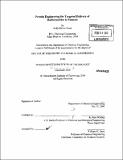| dc.contributor.advisor | K Dane Wittrup. | en_US |
| dc.contributor.author | Orcutt, Kelly Davis | en_US |
| dc.contributor.other | Massachusetts Institute of Technology. Dept. of Chemical Engineering. | en_US |
| dc.date.accessioned | 2010-09-02T17:18:19Z | |
| dc.date.available | 2010-09-02T17:18:19Z | |
| dc.date.copyright | 2009 | en_US |
| dc.date.issued | 2010 | en_US |
| dc.identifier.uri | http://hdl.handle.net/1721.1/58268 | |
| dc.description | Thesis (Ph. D.)--Massachusetts Institute of Technology, Dept. of Chemical Engineering, February 2010. | en_US |
| dc.description | Cataloged from PDF version of thesis. | en_US |
| dc.description | Includes bibliographical references (p. 117-121). | en_US |
| dc.description.abstract | Traditional cancer treatment strategies include systemic chemotherapy, external beam radiation, and surgical excision. Chemotherapy is nonspecific, and targets all rapidly dividing cells. External beam radiation and surgery only target known cancer sites. However, targeted therapeutics, such as antibodies, will bind to all cancer cells that express the targeted antigen, including small metastases that are invisible by current imaging technology. In the past decade, nine antibodies have been approved for the treatment of cancer and are demonstrating moderate success in the clinic. Some of these antibodies have intrinsic toxic effects and block the interaction of growth factors or induce cell death. Other antibodies are conjugated to drugs, toxins, or radioactive isotopes. Unfortunately, antibodies exhibit slow clearance from the body and exposure of healthy tissues to toxins or radiation can result in undesirable side effects that limit the doses that can be safety administered to the patient. We have used rational engineering design and mathematical modeling to develop a novel pretargeted radioimmunotherapy (PRIT) approach for the treatment of cancer. In PRIT, a bifunctional antibody is administered and allowed to bind to a cancer antigen. After sufficient tumor uptake of the antibody, a small molecule carrying a radionuclide is administered and captured by the pretargeted antibody while unbound molecules clear rapidly from the body. PRIT combines the high binding specificity of antibodies with the rapid clearance properties of small molecules. We have identified a small molecule metal chelate, DOTA, which exhibits rapid whole-body clearance and that has demonstrated safety in humans. | en_US |
| dc.description.abstract | (cont.) We engineered a high-affinity antibody fragment specific to DOTA and subsequently engineered a novel bispecific antibody (bsAb) construct with specificity for both DOTA and carcinoembryonic antigen (CEA). The bsAb exhibits retention of parental affinities, in vivo stability, and tumor targeting. The engineered PRIT approach was tested in a mouse tumor model and demonstrates excellent DOTA capture at the site of the tumor with the best 48 hour tumor to blood and tumor to kidney ratios reported to date for CEA targeting. The PRIT approach developed here can be easily applied to other disease targets and has the potential to impact clinical cancer radioimmunotherapy. | en_US |
| dc.description.statementofresponsibility | by Kelly Davis Orcutt. | en_US |
| dc.format.extent | 121 p. | en_US |
| dc.language.iso | eng | en_US |
| dc.publisher | Massachusetts Institute of Technology | en_US |
| dc.rights | M.I.T. theses are protected by
copyright. They may be viewed from this source for any purpose, but
reproduction or distribution in any format is prohibited without written
permission. See provided URL for inquiries about permission. | en_US |
| dc.rights.uri | http://dspace.mit.edu/handle/1721.1/7582 | en_US |
| dc.subject | Chemical Engineering. | en_US |
| dc.title | Protein engineering for targeted delivery of radionuclides to tumors | en_US |
| dc.type | Thesis | en_US |
| dc.description.degree | Ph.D. | en_US |
| dc.contributor.department | Massachusetts Institute of Technology. Department of Chemical Engineering | |
| dc.identifier.oclc | 615635891 | en_US |
